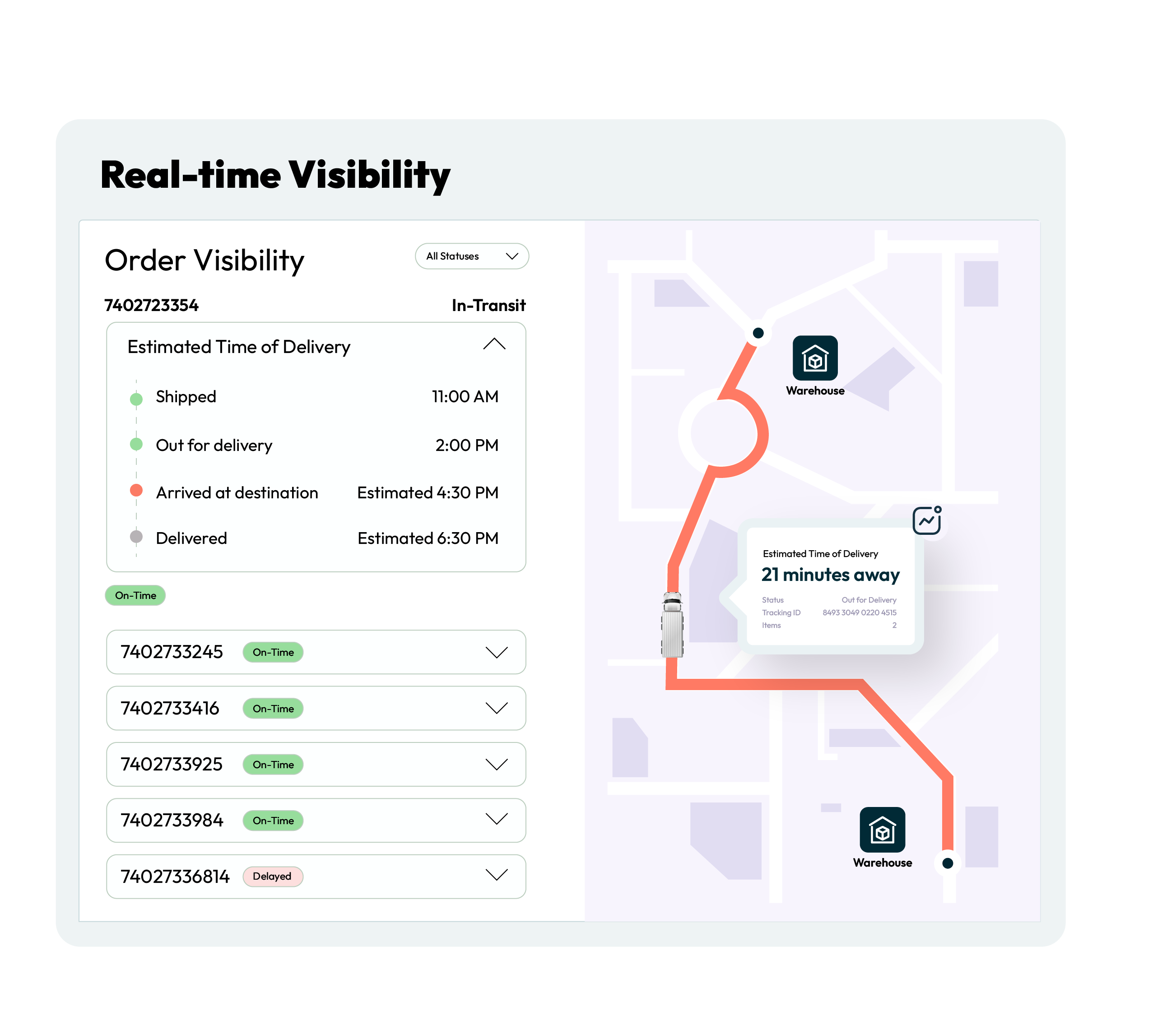- Route
Improving Resource Utilization Through Smarter Route Transportation Models
Table of Contents
- A Familiar Challenge: When Manual Planning Meets Modern Demand
- Rethinking Resource Utilization: The Shift to Smarter Route Transportation Logistics
- Integration and Data Requirements
- The Customer Perspective: What Real-world Challenges Look Like
- Key Concepts in Transportation Routing Software and Smarter Logistics
- Real Results: Efficiency Gains and Operational Impact with FarEye
- Key Metrics to Track in Smarter Route Transportation Logistics
- Why Investing in Smarter Routing is No Longer Optional
- FAQs

Few sectors are as relentlessly scrutinized for performance as logistics. In this environment, route transportation plays a decisive role in determining efficiency and cost control. Every decision, from asset allocation to driver scheduling, has the potential to impact both service quality and the bottom line.
For many US dispatchers, the pressures are only mounting: rising e-commerce expectations, unpredictable urban congestion, and surging order volumes all converge on the same central problem: how to deliver more with less without compromising reliability.
The scale of this challenge is reflected in the numbers. In 2025, the final mile of delivery accounts for nearly 53% of total shipping costs for many US shippers, according to a recent survey. For enterprise operations, this isn’t just a line-item expense; it’s a critical vulnerability.
Yet, while much is said about cutting costs, the more transformative goal is improving resource utilization. It’s not only about reducing what you spend but ensuring every truck, driver, and mile is contributing maximum value. The new playbook for logistics leaders isn’t about pushing teams harder; it’s about making every route, vehicle, and delivery smarter.

A Familiar Challenge: When Manual Planning Meets Modern Demand
For years, dispatchers and allocators relied on manual processes, intuition, and route plans to get trucks out the door. Those approaches are quickly becoming obsolete as volume and complexity grow. Schedulers face a daily maze: balancing shifting orders, fluctuating service times, regulatory requirements, and an evolving mix of in-house, gig, and third-party drivers.
Inconsistent route quality, idle vehicles, and uneven workloads are symptoms seen by every allocator, whether in food delivery, parcel logistics, or big & bulky goods. What often goes unspoken is the silent cost: wasted miles, rising operational expenses, and avoidable driver attrition. Even the most committed teams are limited by the tools at their disposal.
Rethinking Resource Utilization: The Shift to Smarter Route Transportation Logistics
Modern logistics teams are increasingly turning to advanced route transportation models powered by intelligent software. But what sets these new solutions apart isn’t just speed or automation; it’s their ability to reimagine how every resource is planned, assigned, and optimized.
- From Route Planning to Full-fleet Optimization
Traditional routing aimed to minimize driving distance or time per delivery. Smarter route transportation models go further, seeking to maximize fleet-wide efficiency: increasing truck fill rates, balancing driver workloads, and minimizing empty miles across the network.
Sophisticated transportation routing software leverages AI and machine learning to generate optimal routes at scale. It continuously ingests live data traffic, order urgency, service windows, and asset constraints to dynamically adjust plans in real time. Instead of treating every route as an isolated puzzle, these systems orchestrate resources across the entire operation.
- Multi-constraint, Real-time Decision Making
US logistics is defined by variability: one day might bring a surge in small parcel orders; the next, a wave of temperature-sensitive pharmaceutical shipments. Modern software can handle over a hundred constraints per order, factoring in vehicle size, driver skills, traffic disruptions, regulatory hours, customer preferences, and even EV charging stops.
For dispatchers and allocators, this means that the system, not the individual, solves for the most efficient use of every asset, whether it’s the fastest bike for an urban drop-off or the right box truck for a multi-stop route with special unloading requirements.
Integration and Data Requirements
To get the most out of smarter route transportation logistics, enterprises should ensure that key data sources are connected. Typical requirements include:
- OMS/TMS feeds for order and transport management
- Telematics or telematics API for real-time vehicle data
- Driver app GPS for accurate location tracking
- Proof of delivery channel for confirmation and compliance
- Customer notification channel for real-time communication
This foundation ensures the software can generate accurate routes, optimise resources, and provide visibility across the delivery network.
The Customer Perspective: What Real-world Challenges Look Like
Imagine a US-based distributor juggling thousands of orders daily across major cities and suburban hubs. Orders fluctuate, driver availability changes by the hour, and last-minute requests or cancellations are the norm. Planners often face these challenges:
- Manual route allocation leaves drivers under or over-utilized
- Late or inefficient deliveries increase costs and customer churn
- The inability to predict true service times creates backlogs and SLA violations
- Reverse logistics and returns add yet another layer of operational complexity
For many, the result is a reactive environment where teams constantly fight fires, reassign deliveries, update customers, and recalibrate on the fly. The opportunity cost is immense: time spent on manual problem-solving is time not spent on process improvement or strategic growth.
Key Concepts in Transportation Routing Software and Smarter Logistics
Effectively improving resource utilization begins with understanding the foundational concepts that set smarter route transportation logistics apart from outdated approaches.
- AI-powered, Data-driven Routing
AI-driven routing software brings together real-time data and historical analytics. Its engine predicts service times at the level of city blocks, integrates weather and traffic feeds, and adapts on the fly when new orders arrive or conditions change. This not only reduces planning time but also ensures every vehicle is loaded and routed to its full potential.
For example, FarEye’s ML-powered system can pre-plan thousands of orders in minutes, adjusting for over 100 variables per route, from driver shift patterns to customer delivery preferences. Dispatchers can finally move away from reactive, manual allocation to a proactive, automated approach. - Multi-modal and Rate-based Routing
Today’s logistics networks are rarely homogeneous. Companies use a mix of private fleets, third-party providers, and gig economy partners. Advanced software orchestrates deliveries across these models, optimizing for both cost and service quality. With rate-based routing, the system automatically assigns deliveries to the most cost-effective carrier, factoring in hourly charges, capacity, and delivery SLAs.
For instance, if one outlier delivery is more economical to outsource than to stretch internal resources, the platform will suggest this adjustment, driving down total cost while maintaining control and visibility. - Territory and Load Optimization
Efficient route transportation isn’t just about what happens on the road; it starts with intelligent territory planning. Route optimization software uses AI to divide service regions into logical, demand-based zones (down to the level of 1-mile hexagons), ensuring balanced workloads and reducing territory overlap.
This approach also enables dynamic co-mingling of loads from different customers or product lines. The result is fewer empty miles, higher vehicle utilization, and compliance with customer contracts and service windows. - Dynamic SLA and Green Delivery Windows
Customer experience is increasingly shaped by real-time, transparent delivery. FarEye’s platform can offer dynamic delivery windows at checkout, presenting lower-cost green slots that optimize both cost and carbon footprint. These incentives help shift customer demand toward more efficient time frames, smoothing out capacity spikes and lowering operational stress. - Integrated Visibility and Automated Exception Management
Smarter route transportation models bring complete visibility to every stakeholder. Real-time tracking and automated notifications keep both dispatchers and customers informed, reducing missed deliveries and increasing transparency. When disruptions occur, the system triggers automated exception management, rerouting vehicles, reallocating stops, and updating schedules instantly. - Security and Middleware Considerations
While connecting OMS/TMS, telematics, and GPS feeds can seem complex, modern platforms simplify the process through middleware and data normalisation layers. Role-based access and secure authentication protocols protect sensitive delivery data, while SLA tiering ensures mission-critical integrations receive the highest availability and support levels. These measures help enterprises scale with confidence, without compromising on compliance or security.
Real Results: Efficiency Gains and Operational Impact with FarEye
The most effective transportation routing software isn’t theoretical. FarEye has been deployed by leading US courier, trucking, and retail operations. Typical client outcomes include:
- Potential 30% increase in asset and vehicle utilization through AI-powered planning
- 16% reduction in total driving hours with dynamic, constraint-based routing
- Up to 46% reduction in per-delivery costs for food and grocery logistics
- 90% reduction in manual load planning time, freeing staff for higher-value work
- Improved SLA adherence and higher on-time delivery rates, thanks to smarter sequencing and predictive analytics
These outcomes aren’t achieved by pushing drivers harder or cutting corners on service. Instead, they reflect a new way of thinking about resources: every decision is informed by data, every route is optimized for holistic efficiency, and every stakeholder, driver, dispatcher, and customer experiences the benefits.
Key Metrics to Track in Smarter Route Transportation Logistics
A control-tower view helps logistics leaders measure the impact of smarter routing. Core KPIs include:
- Vehicle Utilization: Percentage of fleet capacity effectively used across trips.
- OTIF (On-Time In-Full): Share of deliveries completed on schedule and without errors.
- Average Drive Hours: The mean time drivers spend on active delivery routes.
- Distance per Stop: Kilometres travelled for each completed delivery stop.
- First-attempt Delivery Rate: Percentage of deliveries successfully completed on the first try.
- Cost per Delivery: Average spend per fulfilled order, including fuel, labor, and overheads.
By tracking these metrics, enterprises ensure efficiency gains are visible, measurable, and directly tied to business outcomes.
Why Investing in Smarter Routing is No Longer Optional
For logistics leaders in the US, the future belongs to those who invest in smarter, more adaptable route transportation models. The right transportation routing software serves as the nerve center of the operation, orchestrating resources at scale, improving utilization, and driving sustainable business growth.
FarEye stands out by combining deep AI capabilities with the practical tools dispatchers need for fast route generation, territory planning, rate-based carrier selection, real-time tracking, and automated exception handling. The result is not just operational savings but a strategic advantage in an industry where margins are thin, and customer expectations are high.
Adopting smarter route transportation logistics solutions doesn’t mean lengthy rollouts. Most enterprises follow a clear path: a pilot phase in 2–4 weeks, followed by integration in 2–8 weeks, depending on existing systems. Within 60–90 days, measurable gains in resource utilisation, delivery efficiency, and customer satisfaction usually start to appear, making the transition both practical and results-driven.
As shipping volumes continue to rise and complexity grows, the question is no longer whether to adopt smarter route models but how quickly. In this environment, organizations that harness intelligent routing and resource optimization will not only thrive; they’ll set the standard for what modern logistics can achieve.
FAQs
- What core systems do you integrate with?
Modern transportation routing software typically integrates with Order Management Systems (OMS), Transport Management Systems (TMS), telematics, and driver applications to ensure seamless visibility and accurate data flow. - How long does it take to deploy?
Most enterprises see a pilot phase completed in 2–4 weeks, with full integration taking 2–8 weeks, depending on system complexity. - Does it support EVs and multi-carrier networks?
Yes. Advanced platforms factor in EV charging requirements and optimise routes across multi-carrier networks, balancing cost, efficiency, and service quality.
Source:
https://www.globaltrademag.com/last-mile-delivery-challenges-and-innovative-solutions/

Komal Puri is a seasoned professional in the logistics and supply chain industry. As the AVP of Marketing and a subject matter expert at FarEye, she has been instrumental in shaping the industry narrative for the past decade. Her expertise and insights have earned her numerous awards and recognition. Komal’s writings reflect her deep understanding of the industry, offering valuable insights and thought leadership.
Let's Talk to Our Experts and Optimize Your Deliveries Today!
An expert from our team will reach out within 24 hours


